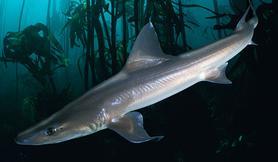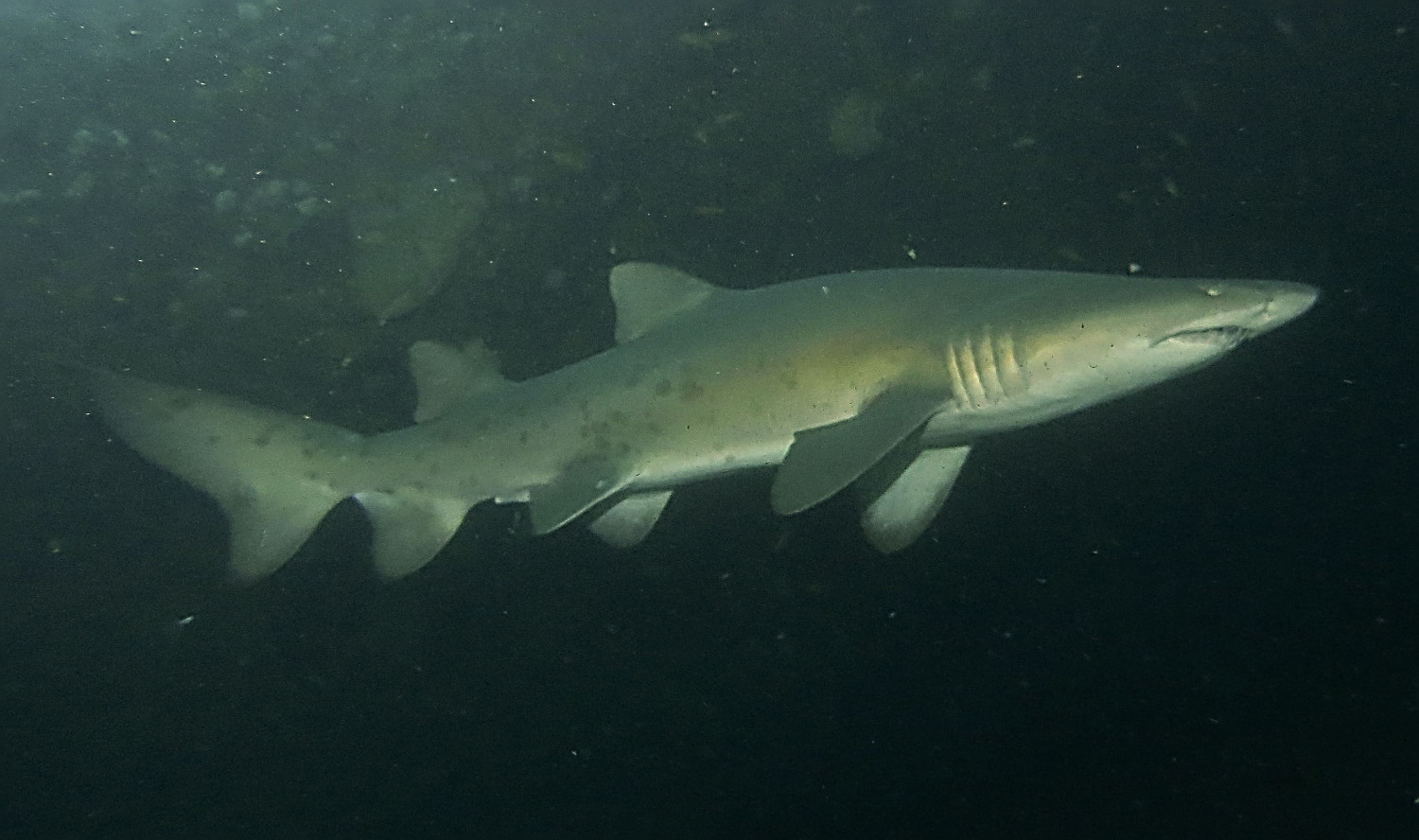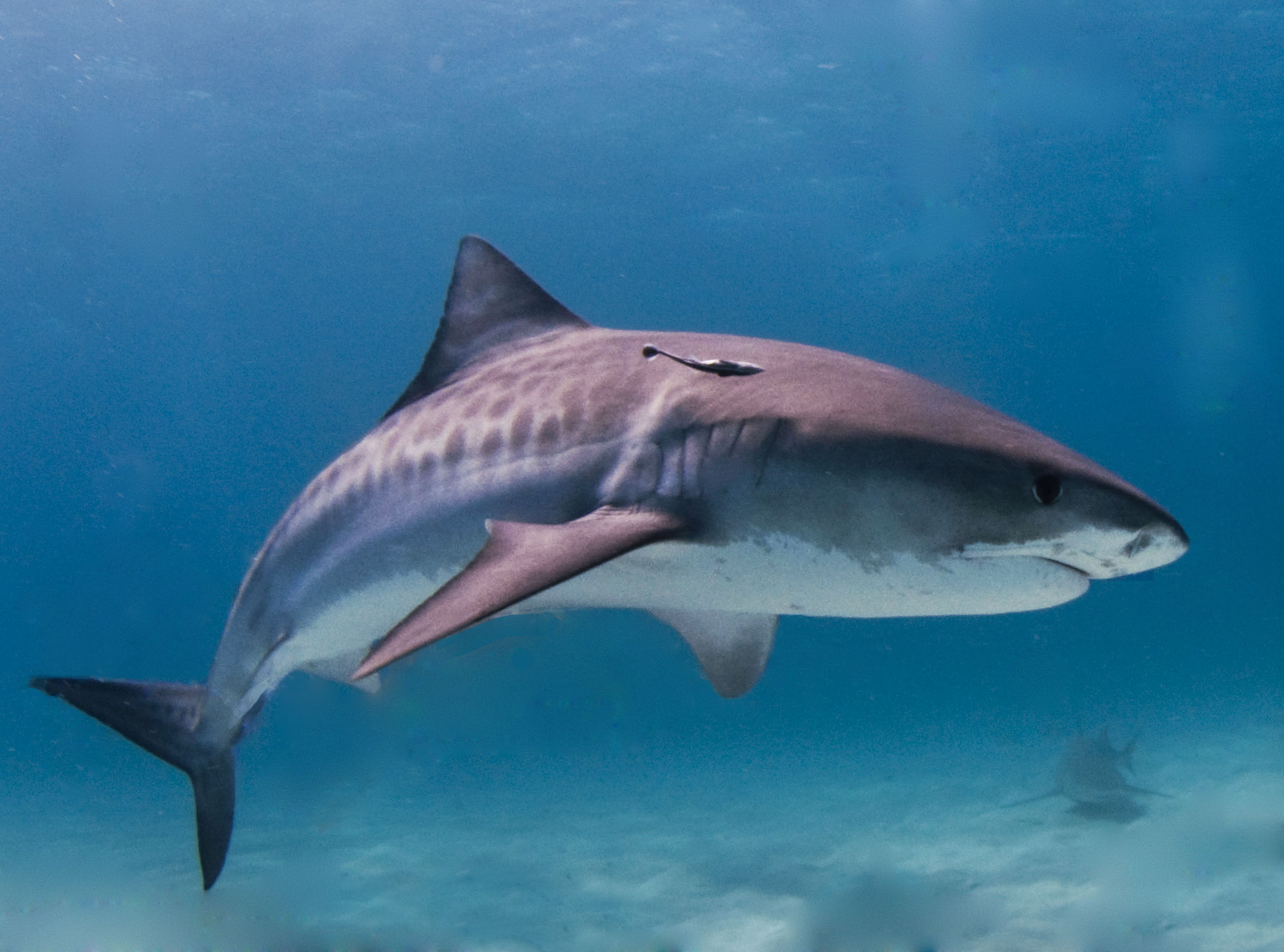Every summer, the beaches of New Jersey are literally swamped with people. Some days in some locations, you couldn't find a spot on the sand to sit on if you tried your hardest. Yes, the beach is an incredibly popular place to be during the summer and so is the ocean. What many beachgoers are completely unaware of is that New Jersey is a sort of hot-spot for sharks. Now before hysteria happens.... Despite many species of sharks visiting New Jersey, attacks are incredibly rare. In fact the last fatal shark attack in New Jersey was back in 1926. Some of the shark species that visit New Jersey are shocking to say the least. Some are small, some are large, but the bottom line is this. Each and every one of the species deserves our highest respect as they are the kings and queens of the oceans and we are in their domain whenever we step foot into the ocean.
Some key things to remember is that sharks are not the monsters that the media portray them to be. These animals have been known to peacefully swim alongside humans more often than not. Divers are in constant contact with these animals and it's only once in a blue moon that you hear about a shark biting a human. Another thing to remember is the simple anatomy of the shark. Sharks don't have a sense of touch like we do. They can't reach out with their fins and get a feel for strange objects. Instead, their sense of touch is literally in their mouth. This is why you hear occasional stories of a shark seemingly chewing on a dock or a corner of a boat. They're trying to figure out what the object is, not trying to eat the object. I'm not going to go into the full details about what sharks do when their really trying to eat here. Another key thing to remember is when these animals are the most active. There is a general rule of thumb that these animals tend to be more active in the evening and in the morning. Another key to remember is that many large species of shark tend to pick off stragglers of groups. Expanding more on that key point. Many large species of shark, including ones I'll be looking at soon, are known to go after seals. The thing to remember is that surfers look like seals. Think about it. Seals have a long body similar to a surfboard. They have to front flippers similar to arms hanging off a surfboard and likewise the feet. The final key point is what has led to many shark attacks around the world. It's known as a case of missing identity. The shark bites a person and is then gone. Very, very rarely does a shark return for another bite. So with all of that being said....
Sharks are all over the world. It doesn't matter what beach you swim off of, sharks are there. That being said, there is no need to fear these animals. Respect them at all times. Respect that you are in their world. Understand that they are not like us and that many shark "attacks" are either cases of mistaken identity or a curious shark is simply trying to figure out just what a strange being in their water is. Respect when they are the most active and your swimming will be a real blast here in New Jersey. Even if you swim in the evening or the morning, your chances of being bitten by are shark are astronomically small to almost non existent. They just tend to be more active at these times. So lets look at some of our visitors!

Starting off pretty famous here. The great white shark is a visitor to New Jersey every year. In fact there is a large tagged female great white that migrates right up the cost every year. The shark's name is Mary Lee and she at this point is the bringer of summer and winter as she migrates past the state in the spring and fall. Other great whites also come by the shore quietly every year as well. Historically speaking, the great white is blamed officially for zero attacks in New Jersey. There is a lot of controversy as to whether or not the great white was the shark involved in the famous 1916 shark attacks in New Jersey. The major controversy lies in that the shark was never actually seen and a couple of the attacks took place in brackish water, an area that great whites typically don't venture into. Either way, great whites can be very aggressive but they are not not known to eat people. Nearly every time a great white has bitten someone, it has vanished instantly. Point in case, these animals are not man eaters, but just another visitor to the Jersey shore. They're rare, but they do come around every year.

On the other end of the spectrum is the little smooth dogfish. This shark is a fisherman's nightmare. Countless fishermen catch these little guys while trying to catch a variety of bony fish. This shark is basically harmless. Besides the fact that they are small, they have very tiny teeth that are more like pebbles than actual teeth. There is nothing to fear from these little guys as they swim around picking off shellfish and crustaceans. They have been known to cause some panic from many uneducated beachgoers that somehow mistaken them for baby great whites and other large species of shark.

The sand tiger shark is the most commonly seen species of large shark and is easily one of the more ferocious looking. One of the more popular aquarium sharks, the sand tiger is also known as the ragged tooth shark and the grey nurse shark. These sharks are usually slow swimming and frequently tolerate divers swimming right along side them. When startled, these sharks can produce an incredible, short lived, burst of speed. In fact they can whip their tales so hard that a void in the water is created and the collapse of that void sounds like thunder. Most impressive! The sand tiger is best known for it's crazy array of teeth that are visible at all times. The well known law when swimming with this shark is to respect it at all times and it will be very tolerant. As with any animal, harass it and it may not be so tolerant. The sand tiger shark cannot legally be targeted by fisherman due to it's conservation status. These sharks are most commonly found around structures such as ship wrecks and are much more active at night than during the day.

If you're looking for a really crazy looking shark in New Jersey, look no further. Believe it or not, New Jersey is visited by scalloped hammerheads when the waters warm up. These sharks are extremely sensitive to it's surroundings and tend to shy away from humans. Over the past couple years, scalloped hammerheads have been seen very close to shore looking for small fish, rays, and crustaceans to eat. Despite their size and aggression towards their prey, these animals have never bitten a person in New Jersey's waters. Personally the hammerhead is one of my favorite sharks and I find it to be quite the fascinating animal. If you have the time and want to see something truly amazing, head on over to youtube and look up some videos of these sharks hunting or even just swimming. Some real awesome stuff there! Seeing these sharks in New Jersey's waters is a real treat as it is an Endangered Species in desperate need of protection.

Boaters beware!!!! New Jersey sits at the northern tip of the whale shark's range. The largest fish in the world will on rare instances visit the waters off of New Jersey. They are by no means frequent visitors, but none the less... The fish with the four foot wide mouth can at any time show up and swallow a person in one gulp... One problem. The throat of a whale shark is roughly the size of a quarter so no worries, this shark can't eat you. Top it off with this... The whale shark has never once bitten a human or even harmed a human. In fact the most whale sharks have done to humans involve stealing fish out of a net and pushing a boat. If you are on a boat this summer and see a spotted fin sticking out of the water. Consider yourself incredibly lucky, you could have just stumbled upon a whale shark!


The sandbar shark is another larger species of shark that inhabits the waters of New Jersey. This shark can be found in varying depths of water and have been known to come very close to shore. These fast moving sharks are very skittish and despite their size, tend to only go after small to medium sized fish. These sharks, along with the dogfish, are often mislabeled as sand sharks (fun fact: sand sharks don't exist). This species of shark is another one that has been known to cause a bit of panic among beachgoers as they have a very large dorsal fin that can be mistaken for a great white if you are unfamiliar with sharks. As is the case with the other large sharks I've mentioned, there is no recorded attack by a sandbar shark in the state of New Jersey. That being said, I don't have any information about whether or not these sharks have bitten any fishermen who've caught these sharks. In that case though I certainly don't blame the shark and I hope no-one would.

Another offshore shark that will from time to time venture inshore is the porbeagle. It looks like a great white, but it's not. It's only on rare instances that these sharks have been seen close to shore. Much like the great white, this shark is partially warm blooded, so they can venture into cooler waters where some other species of shark cant. Also, much like the great white, this shark has seen it's population decrease due to intense fishing. The porbeagle is currently a protected species and one of New Jersey's lesser known visitors. Common theme: There is no record of a porbeagle biting a person in New Jersey.


The highly migratory blue shark will swim by the Jersey shore during the summer months. Sometimes these sharks make their way into shallow waters as one was seen basically surfing through the waves a few years ago. These sharks can be aggressive, but as is the case with the other larger sharks, the blue shark has never bitten anyone in the waters of New Jersey. These sharks are really quite fascinating as they will cross the ocean many times throughout the course of their lives. In addition, unlike most sharks, the blue shark is known to swim in schools. Strength in numbers!


The thresher shark is another offshore species of shark that visits New Jersey. This shark will stun it's prey by smacking it with it's oversized tail making it an easy meal. Legend tells of fishermen who were beheaded by the tail in intense battles with these sharks. Of course that is just legend and there is no actual account of a person being beheaded by a thresher shark. In fact, thresher sharks are not known to be aggressive towards humans at all, unless of course they are on the end of a fishing hook. No, the thresher would much rather smack some small fish around to snack on. Seeing on of these sharks close to shore would be rare as they tend to inhabit deeper, cooler waters.


Speaking of offshore... The shortfin mako shark will also visit New Jersey during the summer months. Much like the thresher and porbeagle, to see one of these sharks close to shore would be surprising to say the least as they enjoy the cooler, deeper waters off the coast. Shortfin makos are an incredibly powerful species of shark that is capable of launching itself 30 feet out of the water. They can also swim at speeds nearing 60 miles per hour. The shark is specially designed for both speed and power. The ambush ability these sharks have is simply amazing. Since they rarely come in contact with humans these sharks tend to be forgotten by folks swimming in the shallows. Still, they are another large visitor to New Jersey. Much as is the case with other sharks listed. There are no recorded attacks on swimmers, but they tend to become very aggressive towards fishermen who have them hooked. Sometimes they have been known to launch themselves onto a boat, injuring the fishermen in the process. Due to overfishing the population of the short fin mako is in decline with less and less large makos seen each year.


The bull shark is another controversial shark that will inhabit the waters of New Jersey. Unlike many of the other large species of shark, the bull shark will come very close to shore and can be very aggressive. This species along with the great white are the two sharks that have been mostly commonly looked at as the sharks responsible for the 1916 New Jersey shark attacks. Many people believe that a bull shark may have been responsible for the attacks as they are known to move into fresh water and brackish water areas. In fact the bull shark has been spotted as far inland as Saint Lois in the Mississippi River. In New Jersey, these sharks are not commonly seen and there has been no confirmed attacks by a bull shark in New Jersey's waters. As is the case with many of the other sharks in New Jersey, this species of shark is currently seeing a population decline.


The list seems endless doesn't it? The next shark is the tiger shark. This is another large species of shark that can be quite aggressive. Many people refer to these sharks as living trash cans as all kinds of random stuff (licence plates for example) have been seen inside these animals. The tiger shark is known to be aggressive, but as is the case with nearly all sharks off New Jersey, there is no confirmed attack by a tiger shark.
I'm going to stop the list there. I will say that more species than the ones I listed visit New Jersey during the summer months. The main point to look at is this. Out of all these sharks, including many well known species, only 2 of them have ever been suspected of biting a human unprovoked. That number folks dates back to the 1500s. It is very, very safe to swim in the ocean off of New Jersey (outside of rip currents, etc). If you come to the beaches here, do not fear the ocean because of the sharks. These animals are at the top of their food chain. They hunt anything from crabs to seals to even dolphins. Humans are simply not on the menu. Mistakes happen. Look how many mistakes we make on a day to day basis. It happens. It happens for sharks too. Cases of mistaken identity are mistakes. Nothing more. Yes, the mistake can cause a lot of damage, but that is the end result of a large animal biting a small animal. In the end, these animals are really just as every bit curious of us as we are of them. We are in their world in the oceans.
I'm going to stop the list there. I will say that more species than the ones I listed visit New Jersey during the summer months. The main point to look at is this. Out of all these sharks, including many well known species, only 2 of them have ever been suspected of biting a human unprovoked. That number folks dates back to the 1500s. It is very, very safe to swim in the ocean off of New Jersey (outside of rip currents, etc). If you come to the beaches here, do not fear the ocean because of the sharks. These animals are at the top of their food chain. They hunt anything from crabs to seals to even dolphins. Humans are simply not on the menu. Mistakes happen. Look how many mistakes we make on a day to day basis. It happens. It happens for sharks too. Cases of mistaken identity are mistakes. Nothing more. Yes, the mistake can cause a lot of damage, but that is the end result of a large animal biting a small animal. In the end, these animals are really just as every bit curious of us as we are of them. We are in their world in the oceans.
I've spent a good amount of time talking to fishermen and divers living along the shore and the story is the same. Respect them and they'll respect you. Divers have seen tiger sharks, as well as nurse sharks hanging near an inlet. Fishermen have seen makos breach 20 plus feet in the air and land safely back in the water. Boaters have seen a great white slowly swim up to bump a boat and go about their business. Swimmers have seen hammerheads, blue sharks, and sandbar sharks tearing through the surf without incident. Point in case. None of these animals cared in the least bit that a person was in the water with them. I can't say it enough. Show the shark respect and he or she will in all likelyhood show it back. So get out there and enjoy the ocean. Don't worry about sharks, but if you happen to see one consider yourself lucky. They are always in the ocean, but rarely seen.
If you were hoping to see more information on these species of sharks, stay tuned as later this summer I'll be highlighting many in their own blog as part of the New Jersey Fintastic Visitors blog series. I'm hoping to get one more blog out, possibly about Shark Week, before the wedding! If by some chance I can't get to it until after, then I hope all of you have a great time until return in late July :)
If you were hoping to see more information on these species of sharks, stay tuned as later this summer I'll be highlighting many in their own blog as part of the New Jersey Fintastic Visitors blog series. I'm hoping to get one more blog out, possibly about Shark Week, before the wedding! If by some chance I can't get to it until after, then I hope all of you have a great time until return in late July :)